The Lenovo ThinkPad P70 Review: Mobile Xeon Workstation
by Brett Howse on June 30, 2016 8:00 AM ESTPerformance
When you hear the term mobile workstation, you should rightly expect that the performance should be right up there with the best notebooks around. In the case of our review unit, we have the almost the top model CPU available with the Xeon E3-1505M, offering higher frequencies than the similar Core i7 models available in this 45-Watt quad-core line. The CPU is 2.7-3.8 GHz, but other than the ECC memory support and faster clock, is otherwise identical to the Core i7 models. Still, it should be interesting to see how it compares to other Skylake quad-core chips we’ve seen.
The other side of the performance coin is the graphics, and here we have one step away from the top model, with the NVIDIA Quadro M4000M, which is the professional version of the GTX 970M.
To compare performance, I’ve added several systems to the graphs which should give us an idea where the ThinkPad P70 lies. We don’t get a lot of mobile workstations through to test, but luckily they aren’t too far off from gaming laptops as far as the CPU performance. If anyone wants to compare the ThinkPad P70 to any other laptop we’ve tested, please use our online Notebook Bench. The Clevo system in the charts is an exception because it uses an 88W Devil’s Canyon desktop CPU, but none of the other systems we’ve tested include a professional graphics card. The GT80 Titan is our only quad-core Broadwell system we tested, and the Surface Book is added just to compare against an Ultrabook class laptop with a discrete GPU option.
PCMark
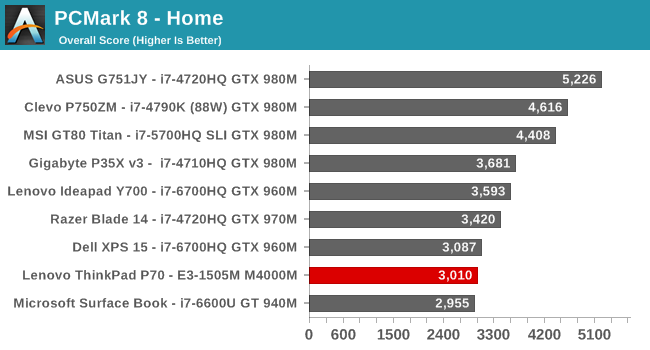
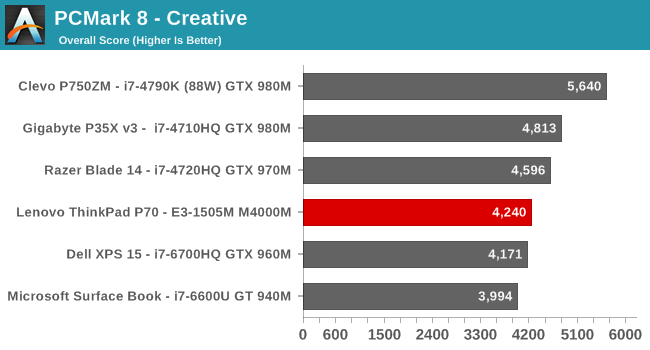
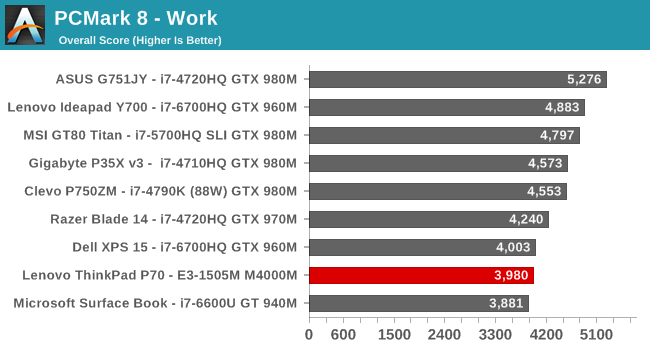
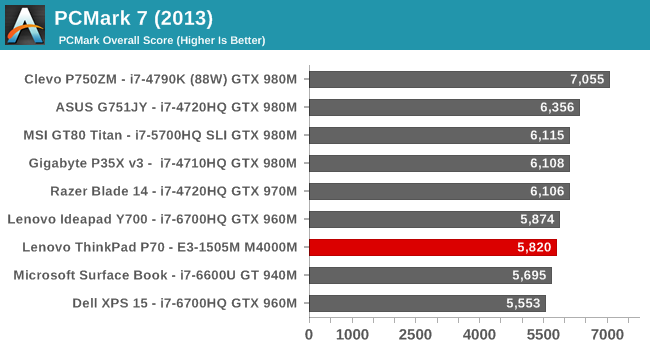
PCMark is a comprehensive test which is influences by all aspects of the system, including CPU, GPU, storage, and even display resolution. The UHD resolution laptops are definitely at a disadvantage, but despite the UHD resolution the Clevo still has a big advantage with the desktop class processor inside. Despite one of the highest frequency Skylake processors inside, the P70 is near the bottom in this test.
Cinebench
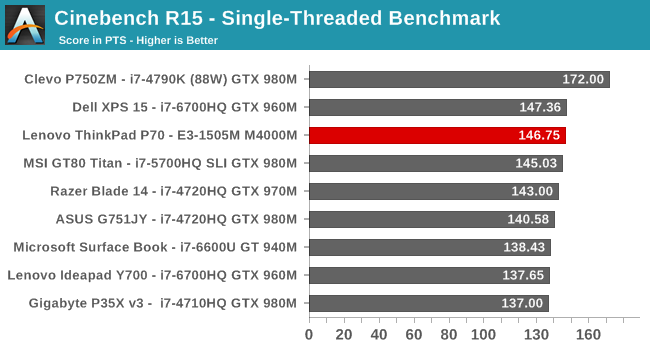
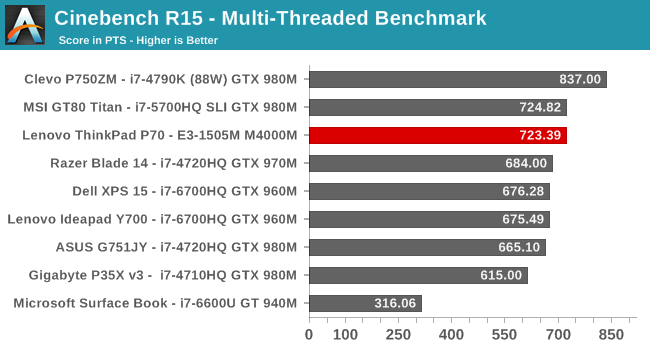
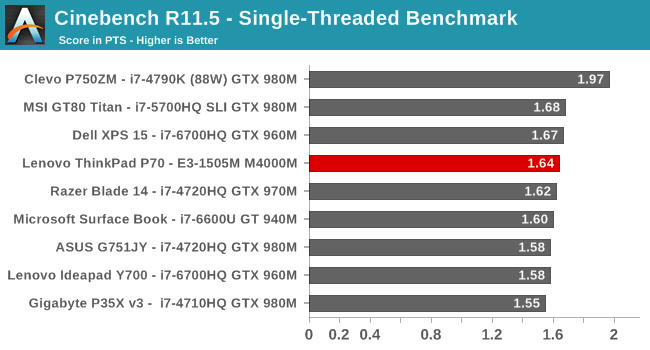
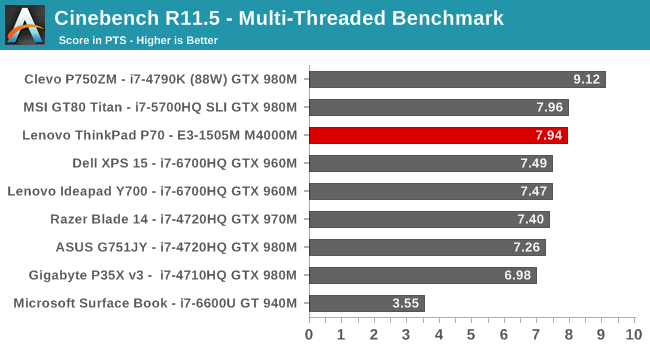
Once again the Devil’s Canyon based Clevo runs away with these tests, but here the Xeon pulls away from the other Skylake based processors, especially on the multi-threaded tests. Both the Dell XPS 15 and Lenovo Y700 are quite far back. Interestingly the Broadwell based GT80 Titan does very well here, and that’s played out on much of the Skylake testing since it was launched.
x264
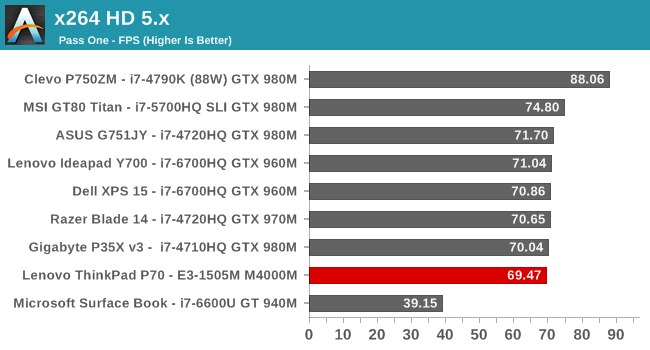
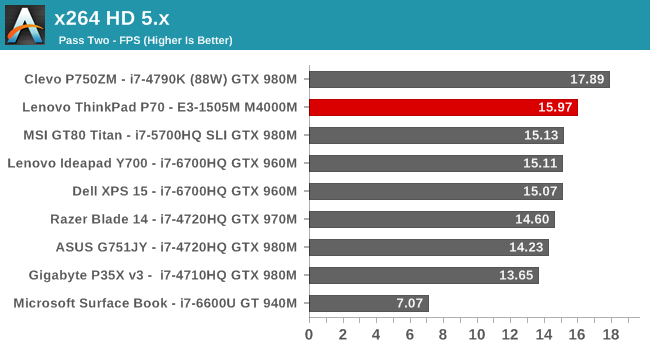
On the first pass, pretty much all of the 45-Watt quad-core processors are pretty close, but on the second pass, the ThinkPad P70 outperforms them all by a nice margin. The Clevo continues to dominate here thanks to having twice the TDP to play with.
Web Performance
Web performance is still very important, and it’s highly influenced by the browser used. When Windows 10 launched, we switched to using Microsoft Edge for browser tests since it was finally competitive with Google Chrome. I’ve highlighted the different browsers used in each test.
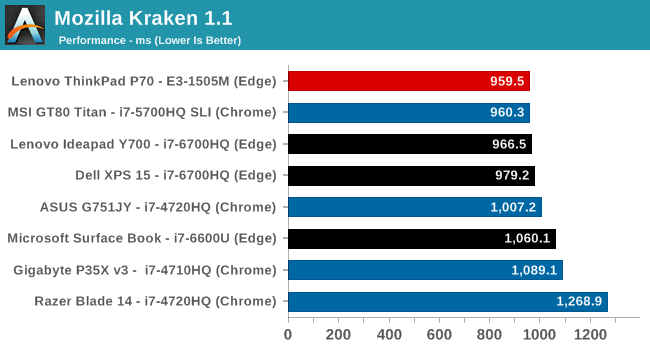
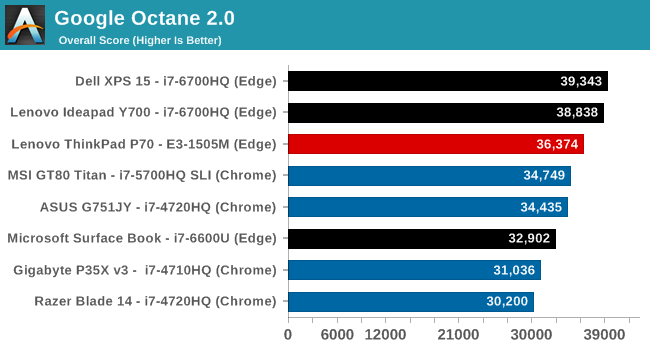
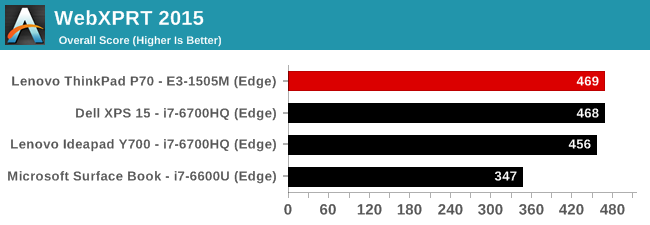
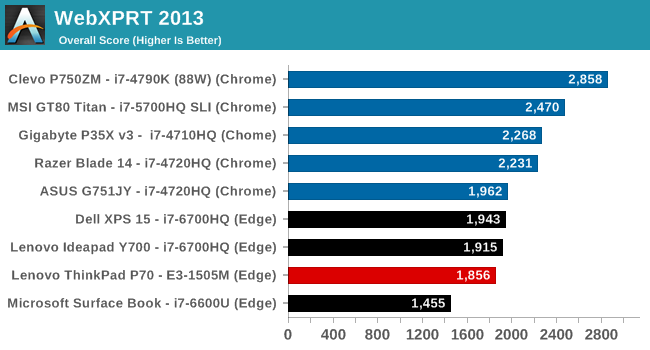
Once again the Xeon is generally a strong performer, but it’s not very far ahead in these tests, if at all.
Storage Performance
Everyone has made the jump to NVMe storage over PCIe, and now PCIe can be the bottleneck instead of SATA. Luckily that’s not a bad thing. Pretty much every NVMe device that has come through has been the Samsung PM951 drive, which is a TLC version. It’s good, but the TLC NAND can be a big bottleneck to write speeds, especially on the lower capacity models where there’s not enough parallel NAND dies to bring the speed back up.
The ThinkPad P70 is the first device I’ve seen that bucks this trend and goes with the Samsung SM951 instead. What’s the difference in a letter you ask? Quite a bit really. The SM951 is the MLC version of the drive, and the performance is significantly better than the PM951. This is actually the second laptop to come through AnandTech with the SM951 installed – with the other being a Lenovo ThinkPad X1 Carbon, specifically sent because it had this drive installed. Good on ThinkPad for not skimping on the drive.
Performance is excellent. Check out the above review if you want a deep dive on this drive, but here’s a quick glance at what it can do.
System Performance Thoughts
The main reason to spend the extra for the Xeon is not overall performance, but for the benefit of ECC memory support. While in most of these tests, the Xeon was ahead of the Core i7-6700HQ quad-core Skylake, it was never by a huge margin. Of course the desktop based Clevo laptop shows just how much more performance you’d still get if you have the TDP to play with, but for most people that need something portable, that’s not really an option. If you need ECC support, you really have no choice but to get the Xeon, but if you don’t need ECC, you can easily save some money on the CPU and DRAM and go with the standard Core based processors.


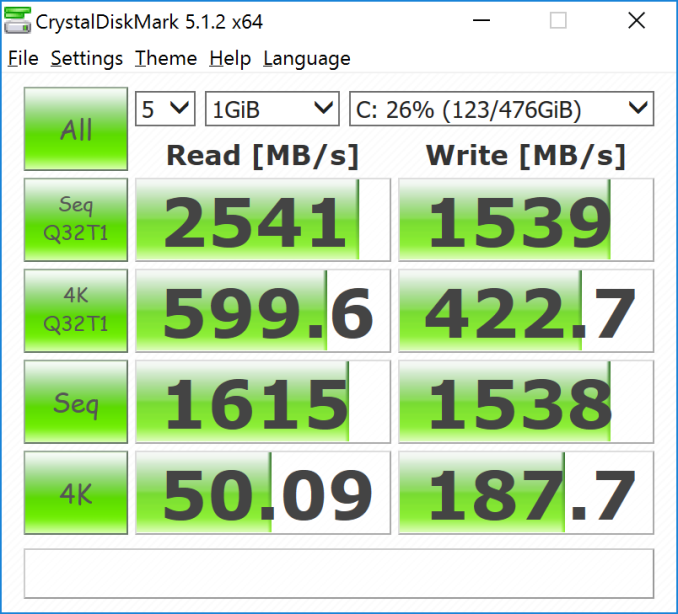








30 Comments
View All Comments
rxzlmn - Thursday, June 30, 2016 - link
That's a really strange outcome with the calibration sensor. Did you review other Lenovo models with a similar sensor before (such as the W540)? Did you contact Lenovo about these results, if yes, did they comment?krumme - Thursday, June 30, 2016 - link
I flat out dont understand what is happening. Why is there a calibration sensor? - ofcource thats going nowhere and a stock calibration must always be better than what this can do? is it to adapt the display then to surroundings?Secondly. On my thinkpad t460 1080 ips the problem is not so much calibration that seems okey out of the box but far to small a spectrum. Its far to limited. IMO hunting that last accuracy is nonsense. Sold my x-rite a year ago. Most screens today come good enough calibrated, the problem is in spectrum and contrast.
osxandwindows - Thursday, June 30, 2016 - link
I will install VMware ESXi on this and then run OS X on it.BillyONeal - Thursday, June 30, 2016 - link
1. That would not be legal.... 2. ESXi doesn't have a console; manageable only remotely. No reason for it to be a laptop at that point.adamto - Friday, July 1, 2016 - link
I did similar and it run very smooth. A free Mac with 32G dual channel memory!http://screencast.com/t/hZCm8YLMF1l9
fanofanand - Thursday, June 30, 2016 - link
This article appears to contain malware, moatads kept trying to download onto my machine. This isn't the first time either. Ryan please tell me you are not selling your readership out by authorizing tracking software for 3rd parties to be downloaded.bill.rookard - Thursday, June 30, 2016 - link
Hmmm... didn't get anything pulling up for any DbD (drive by downloads) but I am running Ad-Block...extide - Thursday, June 30, 2016 - link
Never had that problem here and I do not block ad's on this site. Perhaps your machine is compromised?skifiddle - Thursday, June 30, 2016 - link
I've got it too, along with profile.json. Time for the penicillin.wolfemane - Thursday, June 30, 2016 - link
Yeah I can't even view this site anymore on movile. I load an article and a full screen ad comes up. Browser Insta close. If its not full page ads it's the unbearable promoted stories bull crap at the end of the article. Slows the hell out of my browser. Anantech is getting to the point it's unreadable on mobile devices.